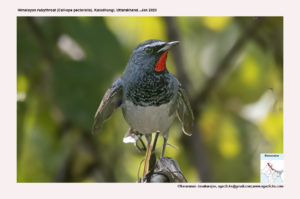White-tailed Rubythroat ( Himalayan Rubythroat)
t

Himalayan Rubythroat Calliope pectoralis
Etymology:
- Calliope : Greek Mythology- fine-voiced chief of the Muses, who presided over eloquence and heroic poetry
- Pectoralis : Latin word for Breast
Vernacular Names: Kash: Yaquat hot, Cachar: Dao gulugajao, Nepal: Gangula
Distribution in India: Breeds in Himalayas, winter visitor in foothills of Himalayas and North East India
Description: Size of 13-14 cm, wt. of 20-26g. The nominate male has prominent white Supercilium, deep red chin and upper throat; black from face to throat side and across breast, rest of underparts are whitish, tinged pale grey on flanks; tail is black, outer feathers are with white bases and tips. The Female is darker and greyer with white throat, white-tipped dark tail.
Habitat: It is found in semi-open alpine and subalpine landscapes above tree-line, such as tall grass thickets in meadows, dwarf rhododendron patches. Winters in lowlands in dense scrub, tea gardens, thickets and grass jungle near streams.
Food Habits: It eats Insects like caterpillars, spiders, molluscs and small reptiles. Forages mainly on ground in cover
Breeding Habits: They breed in May- Aug. Nest a domed structure with large open side entrance, made of dry grass, lined with finer grass, concealed under shrubs or among rocks or roots, or low in vegetation. A clutch of 3–5 eggs laid, incubation period is 2 weeks; nestling period 15 days. Frequently parasitized by Common Cuckoo.